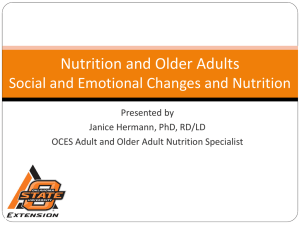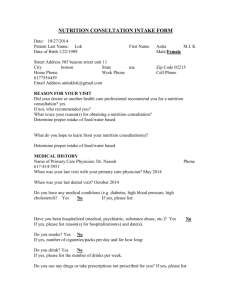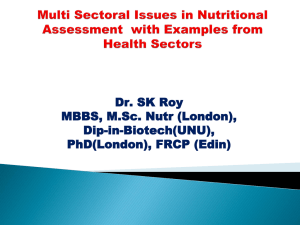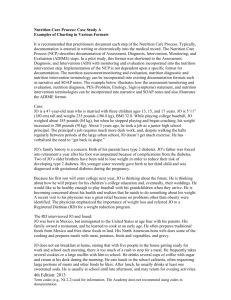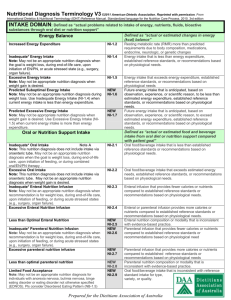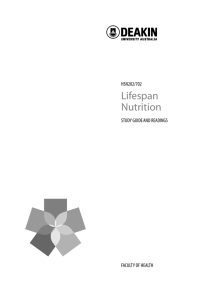Nutrition Diagnosis Terminology: Domains & Classes
advertisement
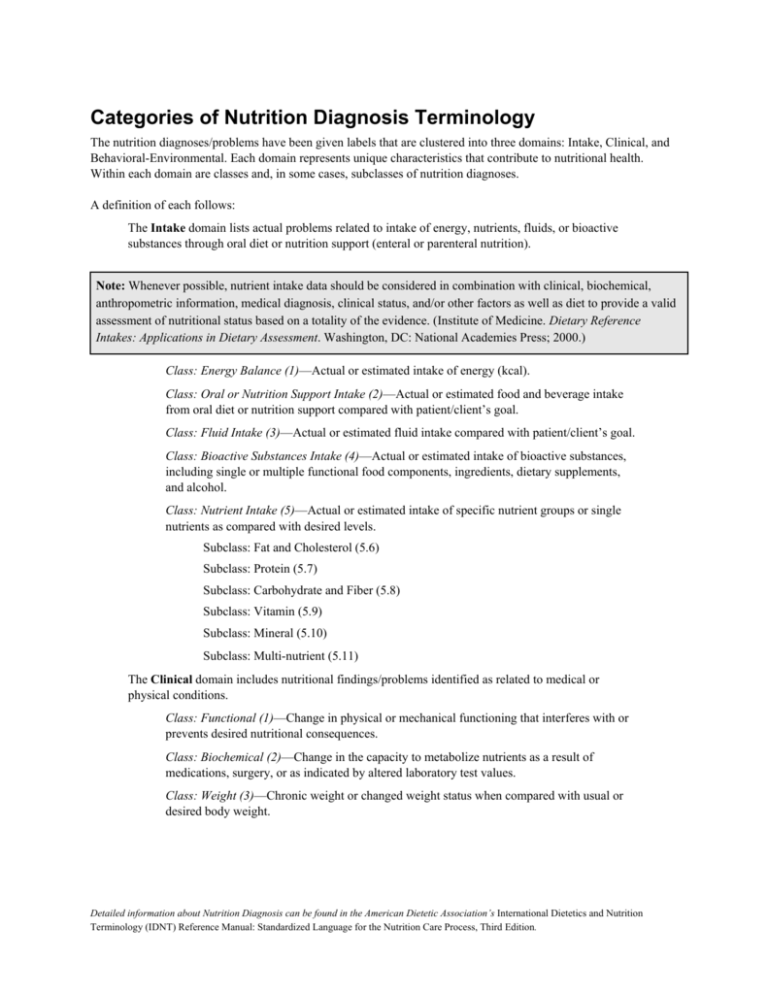
Categories of Nutrition Diagnosis Terminology The nutrition diagnoses/problems have been given labels that are clustered into three domains: Intake, Clinical, and Behavioral-Environmental. Each domain represents unique characteristics that contribute to nutritional health. Within each domain are classes and, in some cases, subclasses of nutrition diagnoses. A definition of each follows: The Intake domain lists actual problems related to intake of energy, nutrients, fluids, or bioactive substances through oral diet or nutrition support (enteral or parenteral nutrition). Note: Whenever possible, nutrient intake data should be considered in combination with clinical, biochemical, anthropometric information, medical diagnosis, clinical status, and/or other factors as well as diet to provide a valid assessment of nutritional status based on a totality of the evidence. (Institute of Medicine. Dietary Reference Intakes: Applications in Dietary Assessment. Washington, DC: National Academies Press; 2000.) Class: Energy Balance (1)—Actual or estimated intake of energy (kcal). Class: Oral or Nutrition Support Intake (2)—Actual or estimated food and beverage intake from oral diet or nutrition support compared with patient/client’s goal. Class: Fluid Intake (3)—Actual or estimated fluid intake compared with patient/client’s goal. Class: Bioactive Substances Intake (4)—Actual or estimated intake of bioactive substances, including single or multiple functional food components, ingredients, dietary supplements, and alcohol. Class: Nutrient Intake (5)—Actual or estimated intake of specific nutrient groups or single nutrients as compared with desired levels. Subclass: Fat and Cholesterol (5.6) Subclass: Protein (5.7) Subclass: Carbohydrate and Fiber (5.8) Subclass: Vitamin (5.9) Subclass: Mineral (5.10) Subclass: Multi-nutrient (5.11) The Clinical domain includes nutritional findings/problems identified as related to medical or physical conditions. Class: Functional (1)—Change in physical or mechanical functioning that interferes with or prevents desired nutritional consequences. Class: Biochemical (2)—Change in the capacity to metabolize nutrients as a result of medications, surgery, or as indicated by altered laboratory test values. Class: Weight (3)—Chronic weight or changed weight status when compared with usual or desired body weight. Detailed information about Nutrition Diagnosis can be found in the American Dietetic Association’s International Dietetics and Nutrition Terminology (IDNT) Reference Manual: Standardized Language for the Nutrition Care Process, Third Edition. The Behavioral-Environmental domain includes identified nutritional findings/problems that relate to knowledge; attitudes/beliefs; physical environment; access to food, water, or nutrition-related supplies; and food safety. Class: Knowledge and Beliefs (1)—Actual knowledge and beliefs as reported, observed, or documented. Class: Physical Activity and Function (2)—Actual physical activity, self-care, and quality-oflife problems as reported, observed, or documented. Class: Food Safety and Access (3)—Actual problems with food safety or access to food, water, or nutrition-related supplies. Detailed information about Nutrition Diagnosis can be found in the American Dietetic Association’s International Dietetics and Nutrition Terminology (IDNT) Reference Manual: Standardized Language for the Nutrition Care Process, Third Edition.

